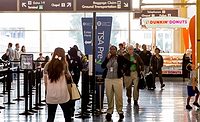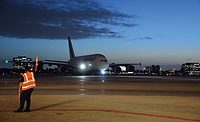More than a dozen airports in the U.S. will receive new security, including inline baggage handling systems, security video, checkpoint technologies and imaging units. The new security efforts will come from funding announced by the Department of Homeland Security.
It includes approximately $254 million in ARRA funds for inline baggage handling systems at six airports—including Washington Dulles International Aiport ($154 million); Mineta San Jose International Airport ($20.9 million); San Antonio International Airport ($14.4 million); Portland (Maine) International Jetport ($9.2 million); Port Columbus International Airport ($35.2 million); and Hartsfield-Jackson Atlanta International Airport ($20 million).
Inline baggage handling systems eliminate the need for passengers to walk checked baggage to a screening location and wait before proceeding to the security checkpoint, incorporate enhanced explosive detection technology to provide on-screen viewing capabilities for TSA officers conducting baggage screenings and reduce the number of re-scans and physical bag searches.
DHS also announced approximately $38 million in funds to support new and enhanced security video systems for surveillance capabilities at six airports—Chicago Midway International Airport ($2.7 million); Little Rock National Airport/Adams Field ($5.9 million); Kansas City International Airport ($9.4 million); Omaha Eppley Airfield Airport ($3.6 million); Washington Dulles International Airport ($8.1 million); and Tampa International Airport ($8.1 million).
Funds were also allocated for the purchase and installation of multiple additional checkpoint technologies—including $15 million for Explosive Trace Detection (ETD) units, which detect traces of explosives; and $22 million for Bottled Liquid Scanners (BLS), a technology that screens medically necessary liquids such as infant formula and liquid medications to ensure they do not contain a threat. More than $25 million will fund the purchase and deployment of approximately 150 backscatter advanced imaging units to airports across the nation—designed to bolster security by screening passengers for concealed threats of all kinds without physical contact.
The deployment of the units, said DHS, follows a successful pilot phase, during which 46 imaging technology units were deployed at 23 airports and passengers opted to use imaging technology for primary screening 99 percent of the time.





